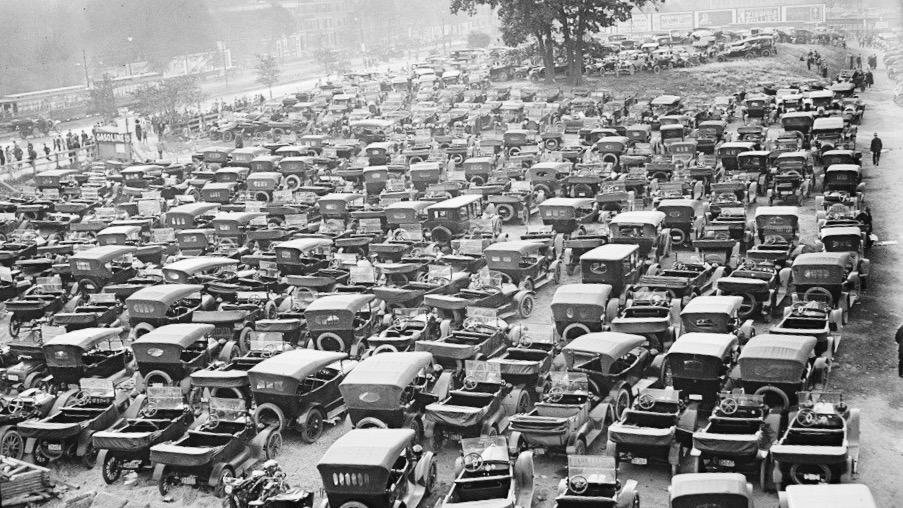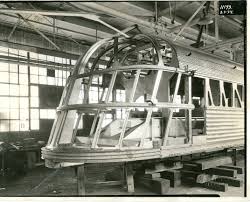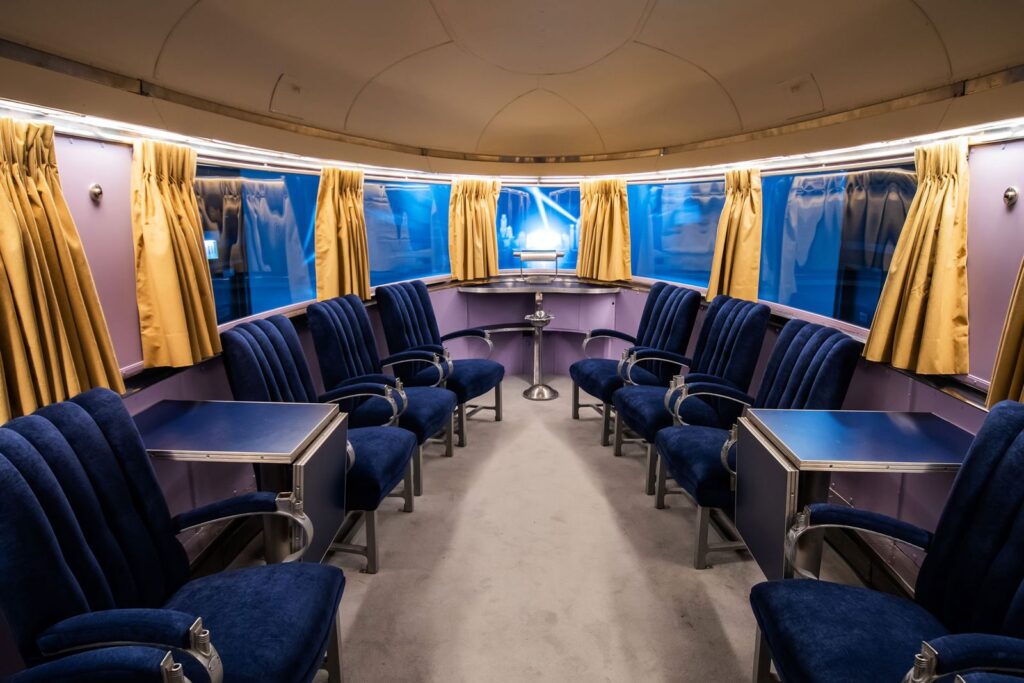- Perspective – June 2024
- Columbus Stainless Advert
- Fastenright : Advert
- Market Intelligence
- Industry Awards
- The Sassda Columbus Stainless Awards : Advert
- Professional Profile : Heinrich Vollgraaff
- Technical Insight – Stainless Steel the healthiest choice for clean machines
- State of the Stainless Steel Nation
- Navigating Challenges in Stainless Steel: EMV Africa’s Strategic Response
- The Zephyr Pioneer – Take a train ride back to the future
- Good neighbours! Investment Opportunities in Zimbabwe, Eswatini & Mozambique
- NDE Advert
- Columbus Stainless Grinding Solution Wins Top Industry Award
- Forging the future: Sassda Shines at Machine Tools Africa Expo
- SASSDA/SAIW Annual Regional Golf Days 2024: A Swinging Success
Anyone watching a 1920 Model T automobile jerking and backfiring down the road would find it hard to believe that the object of so much derision would one day threaten the very existence of the railroad as a passenger carrier. But that is exactly what happened

In 1924, the Burlington Railroad carried a whopping 18-million passengers. Only five years later, as the automobile’s popularity increased, that figure dropped to 13.8-million. And by 1933, amid the Great Depression, only 7-million travellers rode the rails. Passenger revenues followed a parallel descent. To the amazement of many, the railroad, with a tradition as grand as any in America, was slowly being replaced by an army of 30 mph automobiles.
Luckily for the railroad industry and the travelling public, a figure appeared on the scene in the early 1930s, with the knowledge and determination to build a train to meet the demands of the 20th century traveller. His name was Ralph Budd, and he became president of the Burlington Railroad in 1932.
By the time Budd arrived at Burlington Railroad, the automobile had edged out trains as the favoured means of transportation, even for long distance travel. Budd was among the first to admit that “the loss of railway passenger traffic during the last decade has been caused by a shift from the railways to the highway, and not from a decline in total travel. The total passenger one-mile units of travel have increased.”
Budd reasoned that since automobile engineers had derailed the passenger train, they could be the ones to put it back on the tracks. Such thinking implied the use of a kind of automotive internal combustion power instead of the steam locomotive, upon which the industry had relied for a century.
Stainless steel enters the rail transport industry
One of Budd’s first moves was to visit the Edward G. Budd Manufacturing Company in Philadelphia. Ralph Budd was not related to the company which had been the first to produce all-steel automobile wheels and the all-steel automobile body. Now it was ready to tackle passenger
train construction.
At the Budd Co. plant, the Burlington president examined a test rail car body, incorporating several radical innovations, including a gas engine and rubber tyres. Budd immediately dismissed these alterations as impractical. What caught his attention was the rail car’s stainless steel construction. The material was lightweight yet strong, and it lasted forever. The problem was that no one had been able to figure out a way to build stainless steel rail cars in a practical shop operation. Fortunately, the Burlington president’s timing was exactly right. The Budd Company had just patented its newly devised “Shotweld Process.” The system allowed rivet-less seams of stainless steel to be joined without reducing its corrosion-resistant qualities.
At the same time, it provided a joint stronger than the steel it held together. Ralph Budd knew a good product when he saw one. He decided this would be the material for the new train he wanted to build to recapture the rail passenger market. On June 17, 1933, barely a year since he first stepped into office, Ralph Budd signed a contract with the Budd Co. to construct a train out of stainless steel. The firm was given free rein in the design of the train.
Grade selection considering mechanical and physical properties:
 The first stainless steel railcars were made from an austenitic alloy produced by Allegheny and classified by Budd as 18-8 steel, consisting of 18% chromium and 8% nickel. High carbon content made this stainless steel susceptible to chromium carbide precipitation in the HAZ of welds and to subsequent intergranular corrosion. The need to limit dwell time, in the critical temperature range, motivated for Budd’s experts to invent the short-time spot welding process (‘shotweld’).
The first stainless steel railcars were made from an austenitic alloy produced by Allegheny and classified by Budd as 18-8 steel, consisting of 18% chromium and 8% nickel. High carbon content made this stainless steel susceptible to chromium carbide precipitation in the HAZ of welds and to subsequent intergranular corrosion. The need to limit dwell time, in the critical temperature range, motivated for Budd’s experts to invent the short-time spot welding process (‘shotweld’).
In the 1950s, 201 and 202 steels were also applied. In their chemistries, a substantial part of the nickel is replaced with manganese. Later, 17-7 Type 301 steel was introduced. In the 1980s, the advent of argon-oxygen decarburization allowed the fabrication of low-carbon stainless steels containing less than 0.03% C. This carbon level prevents the sensitization of stainless steel caused by welding, either with resistance or fusion processes.
Notably, Duplex stainless steels have the potential for application, because of their high strength in larger thicknesses. However, they will not become popular in the production of railcars. They are more expensive than austenitic steels, and in lower thicknesses (up to about 5 mm), cold-worked austenitic materials are stronger than duplex steels. Where larger thicknesses are required, highstrength, low alloy (HSLA) steels with yield strengths up to 700 MPa are commonly used.
The use of martensitic and ferritic steels is limited to non-structural applications. In typical descriptions of austenitic stainless steels, their mechanical properties are those in the annealed condition. However, the strength of these materials may be significantly increased by cold deformation, such as thickness reduction in cold rolling, forming, or bending. Deformation strengthening of austenitic steels results from the partial transformation of austenite into martensite.
The strengthening efficiency of cold rolling depends on the material thicknesses. For example, in thicknesses up to 1 mm, tensile strength close to 1300 MPa and yield strength (0.2% proof), close to 1000 MPa, may be achieved. For 5-mm thick materials, the achievable values are 1000 and 750 MPa, respectively. The high strength-to-weight ratio allows for cold-worked stainless steel to be considered a lightweight material.
Austenitic stainless steels can be bent with ease. Even in the cold-worked condition, the material may be safely bent with a radius equal to twice its thickness. The formability of austenitic steels is strongly dependent on the initial condition of the material. Annealed material can be formed without difficulty, while the forming potential of cold-worked materials is limited. If material is to be formed, its final properties resulting from deformation may be considered for design.
Three properties of austenitic steels are important for resistance welding - electrical resistivity, thermal conductivity, and the coefficient of thermal expansion. Compared to carbon steel properties, austenitic steels have a resistivity five times higher, thermal conductivity three times lower, and thermal co-efficient one-third higher.
During welding, austenitic stainless steels do not undergo the y-a transformation, which ensures their good metallurgical weldability. A limited recrystallization occurs in the HAZ, leading to some softening. However, this has no consequence on the strength of resistance welds. The HAZ remains ductile in all cases.
In either a peel or chisel test of spot welds, a well-defined button is always obtained. The high resistivity of austenitic steels allows for rapid obtaining and growth of the weld nugget. This is further enhanced by the low thermal conductivity, which limits heat sinking into the surrounding material.
As a result, low amperages are required, and spot-welding multiple part combinations of a large total thickness are possible. The high coefficient of thermal expansion results in a tendency to produce nugget shrinkage discontinuities as well as high residual stresses in welds and distortion of assemblies. To prevent both occurrences, high forging forces are applied.
Power for a new era in rail transport
Budd needed a power unit for his stainless steel train, to replace the hopelessly outdated steam engine. The expertise of no less than three firms was brought to bear on the problem of building a two-cycle diesel engine to meet the demands for train engines with increased horsepower. The work was led by the General Motors Co., which was aided by the company’s 1930 acquisition of the Winton Engine Co. and railcar builder Electro-Motive Co.
A major turning point occurred in 1933, when the Kettering team’s eight-cylinder, 600-hp, 8-201 engine, with a weight-to-power ratio of only 20 pounds per horsepower, was chosen to supply power to the Chevrolet exhibit at Chicago’s “Century of Progress Exposition.”
While visiting the fair, Ralph Budd came upon the display and immediately decided that the lightweight diesel engine would provide the power for his all-new, all-important passenger train. As Budd saw it, the diesel railroad was the railroad of the future and if any company could put the diesel engine in a train, it was General Motors.
Approximately one year later, on May 26, 1934, the Pioneer Zephyr No. 9900 made its grand debut with a record-setting 1,000-mile dawn-to-dusk run from Denver to Chicago in 13 hours. Appropriately enough, the Zephyr was named after the Greek god of the west winds. It was designed for speeds of approximately 110 mph. Not only was the Pioneer Zephyr faster and lighter than its predecessors, but it also reduced Burlington’s cost of passenger train operation. A new era in railroading history had begun.
The interior revolution
 The high operating standards of the world’s first high-speed, diesel-propelled stainless steel three-car train were matched by the Zephyr’s painstaking interior furnishings. The first car held a diesel engine, an engineer’s cab, a 30-ft. railway post office, and space for baggage.
The high operating standards of the world’s first high-speed, diesel-propelled stainless steel three-car train were matched by the Zephyr’s painstaking interior furnishings. The first car held a diesel engine, an engineer’s cab, a 30-ft. railway post office, and space for baggage.
The second car carried a larger baggage compartment, a buffet grill and, at the rear portion of the unit, a 16-ft smoking section with seats for 20 passengers.
Third and last was a 31-ft. compartment with seats for 40 persons, and a solarium lounge with chairs for 12. Before the Pioneer Zephyr, the travelling public knew only ornate but gloomy railroad car interiors. All that changed with the high-stepping Zephyr. Each compartment had a distinctive colour harmony coordinating wall colours, window drapes, upholstery, and floor covering. But more important than the Zephyr’s looks, were the uplifting effect it had on a mid-Depression America and its effect of reaffirming the faith of the people in the free enterprise system.
A tradition established, a future defined
In addition to its technological achievements, the Pioneer Zephyr led to a revival of the public’s interest in rail passenger service. Settled comfortably in the welcoming arms of the modern train, thousands of Americans watched the nation’s prairies, mountains, and forests fly by. Glamour queens of the era liked nothing better than to make a grand entrance into town by rail, greeted by crowds waiting on the station’s platform.
Stainless steel remains a cornerstone material in modern rail transport. It is the standard material for rail applications all over the world especially in Japan and the USA. Modern technology developments and the importance of life cycle costing, make stainless steel an attractive option for rail cars.
Today stainless steel is used in a wide range of railway applications. Regional, commuter, metro, underground and light rail trains depend on stainless steel for solutions.
Material selection and design criteria are affected by the specific operating conditions and many of these are met by stainless steel. As such, stainless steel should be used whenever corrosion resistance, fire safety, ease of cleaning, minimal maintenance and visual attractiveness are key requirements.
| Stock type | diesel-electric passenger one-directional trainset |
| In service | 1934–1960 |
| Manufacturer | Budd Company |
| Constructed | 1934 |
| Entered service | November 11, 1934 |
| Number built | 1 trainset (3 cars) |
| Formation | 1: cab/engine/storage 2: baggage/RPO/buffet/coach 3: coach/observation |
| Fleet numbers | 9900 |
| Capacity | 72 passenger seats, 25 long tons (25 t; 28 short tons) of baggage |
| Operators | Chicago, Burlington and Quincy Railroad |
| Specifications | |
| Car body construction | stainless steel |
| Train length | 197 ft 2 in (60.10 m) |
| Car length | 74 ft 0.125 in (23 m) (power car) 57 ft 8 in (17.58 m) (intermediate car) 63 ft 6 in (19.35 m) (rear car) |
| Width | 9 ft 1.0625 in (277 cm) (body) 9 ft 10 in (300 cm) (handrails) |
| Height | 12 ft 1.1875 in (369 cm) |
| Wheel diameter | 36 in (910 mm) (drive wheels), 30 in (760 mm) (ride wheels) |
| Weight | 208,061 lb (94,375 kg) |
| Prime mover(s) | EMD 201A |
| Engine type | diesel |
| Cylinder count | 8 |
| Cylinder size | 8 in (200 mm) bore, 10 in (250 mm) stroke |
| Traction motors | 2 |
| Power output | 660 hp (490 kW) |
| AAR wheel arrangement | B-(2+2)-2 |
| Wheels driven | 2 |
| Bogies | 1 motor bogie,
2 non-motor Jacob’s bogies, 1 non-motor bogie |
| Seating | open coach (2+2), observation lounge |
| Track gauge | 4 ft 8+1⁄2 in (1,435 mm) |

